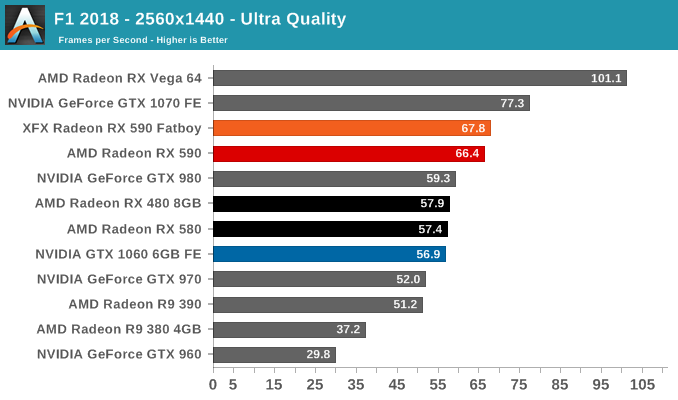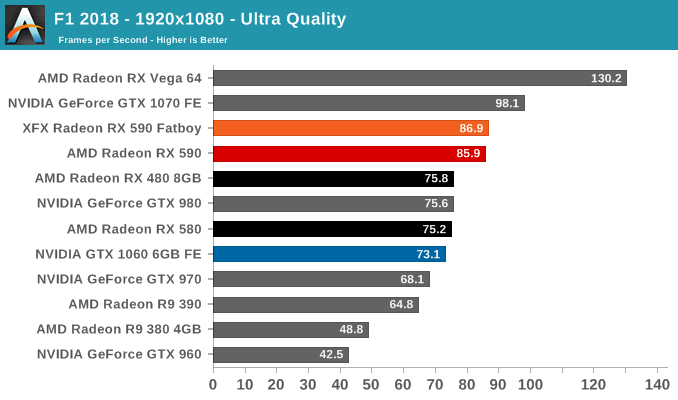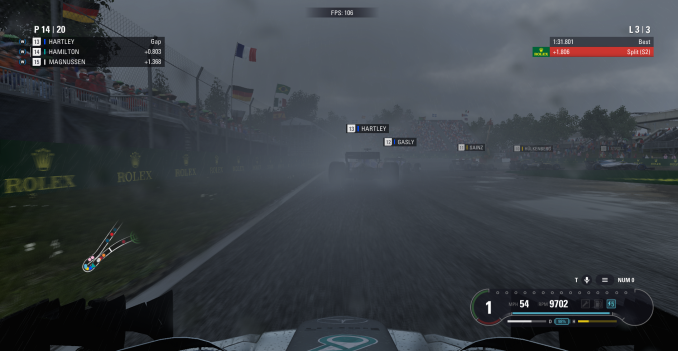The AMD Radeon RX 590 Review, feat. XFX & PowerColor: Polaris Returns (Again)
by Nate Oh on November 15, 2018 9:00 AM ESTF1 2018 (DX11)
Succeeding F1 2016 is F1 2018, Codemaster's latest iteration in their official Formula One racing games. It features a slimmed down version of Codemasters' traditional built-in benchmarking tools and scripts, something that is surprisingly absent in DiRT 4.
Aside from keeping up-to-date on the Formula One world, F1 2017 added HDR support, which F1 2018 has maintained; otherwise, we should see any newer versions of Codemasters' EGO engine find its way into F1. Graphically demanding in its own right, F1 2018 keeps a useful racing-type graphics workload in our benchmarks.


In F1 2018, the RX 590 again carves out a clear space in between the GTX 1070 and GTX 1060 6GB. Given that the GTX 1060 6GB FE already performs slower than the RX 480 8GB, the RX 590 ends up closer to the GTX 1070 FE than to the GTX 1060 6GB FE.











136 Comments
View All Comments
silverblue - Thursday, November 15, 2018 - link
I was talking about the process; I know the 2000 series has done well.I didn't even know TSMC had a 12nm process, but either it's not very well suited to this application or AMD have just clocked it far too highly, so it's not a successful product in that sense.
frenchy_2001 - Thursday, November 15, 2018 - link
Nvidia's Volta and Turing are fabbed on TSMC 12nm.So, it seems to work well for GPUs, but AMD's architecture is just not competitive in their perfs/watt.
silverblue - Thursday, November 15, 2018 - link
I completely forgot about them.It feels like Polaris is bottlenecked in some way, and increasing clock speeds is just a brute force way of alleviating the issue at the cost of significant power consumption. Perhaps the design is just broken to begin with.
Manch - Friday, November 16, 2018 - link
Memory bandwidth is the bottleneck for Polaris.deksman2 - Friday, November 16, 2018 - link
Power consumption - wise, its the process node from GLOFO that's limiting Polaris mainly from achieving high frequencies and low power consumption.GLOFO nodes are designed for low clocks and mobile parts... 12nmLP is designed for the same, and AMD used it for RX 590.
That's why power consumption explodes on high frequencies.
deksman2 - Friday, November 16, 2018 - link
Polaris is bottlenecked by the GLOFO 12nmLP process that's being used here.It's designed for low clocks and mobile parts.
There was NOTHING posted about AMD using TSCM 12nm node for Polaris refresh. TSMC 12nm was slated for Nvidia.
AMD gets to use TSMC 7nm high performance process node for Zen 2, Vega Instinct and Navi.
eek2121 - Saturday, November 17, 2018 - link
"Limited" is the word you want to use to describe Polaris. "Broken" would imply it doesn't work at all. Polaris was never meant to be a high end architecture. They have just been doing refreshes because they are likely reorganizing their GPU division and coming up with a new architecture to replace GCN. Doing something like that takes time, and AMD has to continue generating revenue. Also, the 590 is not a bad card at all, while I have a 1080ti in my machine, I would definitely consider a Polaris card in any new machine I build (for friends, family, etc.)deksman2 - Friday, November 16, 2018 - link
Incorrect on AMD's architecture not being competitive because AMD is still using GLOFO 12nm LP process for RX 590 which is designed for low clocks and mobile parts.TSMC 16nm and 12nm processes are designed for high performance and efficiency... those nodes are superior to GLOFO (that's why AMD's GPU's end up sucking up A LOT of power at high frequencies - its because the process node from GLOFO cannot take it, and partly because the compute performance on Polaris is a lot bigger than on GTX 1060).
porcupineLTD - Thursday, November 15, 2018 - link
I highly doubt that, any source?deksman2 - Friday, November 16, 2018 - link
Actually 'Cooe', you are incorrect.AMD is using 12nmLP process from GLOFO for RX 590.
You can read about that here:
https://www.pcgamesn.com/amd-rx-590-overclocking-p...
Furthermore, the power consumption on RX 590 should be a dead give-away, because this is exactly the same thing that happened for Ryzen+ too (not to mention the fact we had 0 indications that AMD would refresh Polaris on TSMC 12nm process. NV got access to 12nm TSMC process, not AMD... AMD got access to TSMC's 7nm high perf. process and they have reserved Zen 2, Vega Instinct and Navi for that).
They increased the frequencies on 12nmLP, but as a result they also saw an increase in power consumption.
Polaris is clocked WAY beyond the voltage comfort zone on GLOFO processes (which are designed for low clocks and mobile parts).
If they wanted a refresh, they should have just dropped the frequencies down to 580 levels and call it a more power efficient rebrand.
If AMD moved to TSMC 12nm for RX 590, power consumption on this GPU would actually be lower than on GTX 1060 with those frequencies.